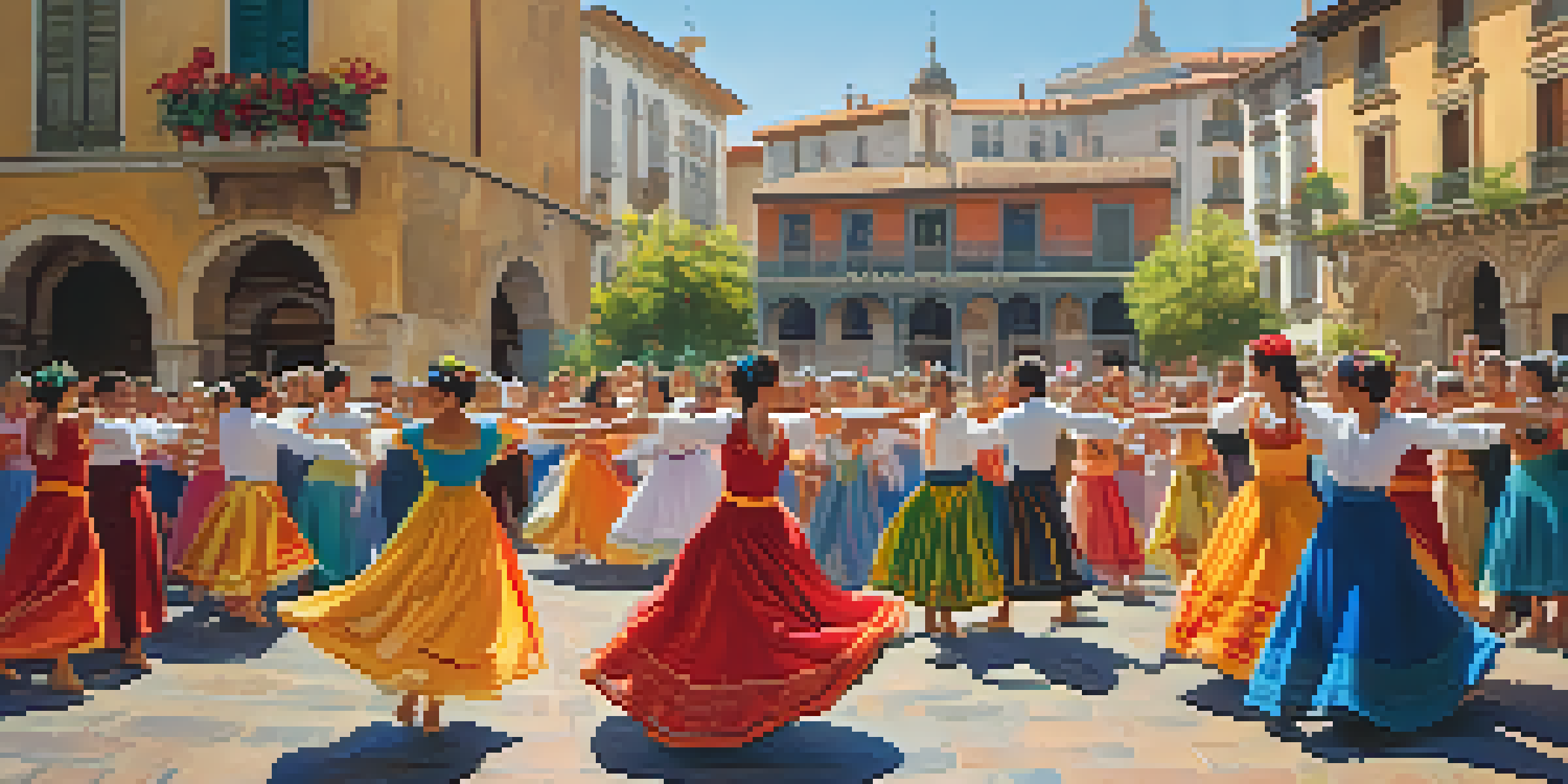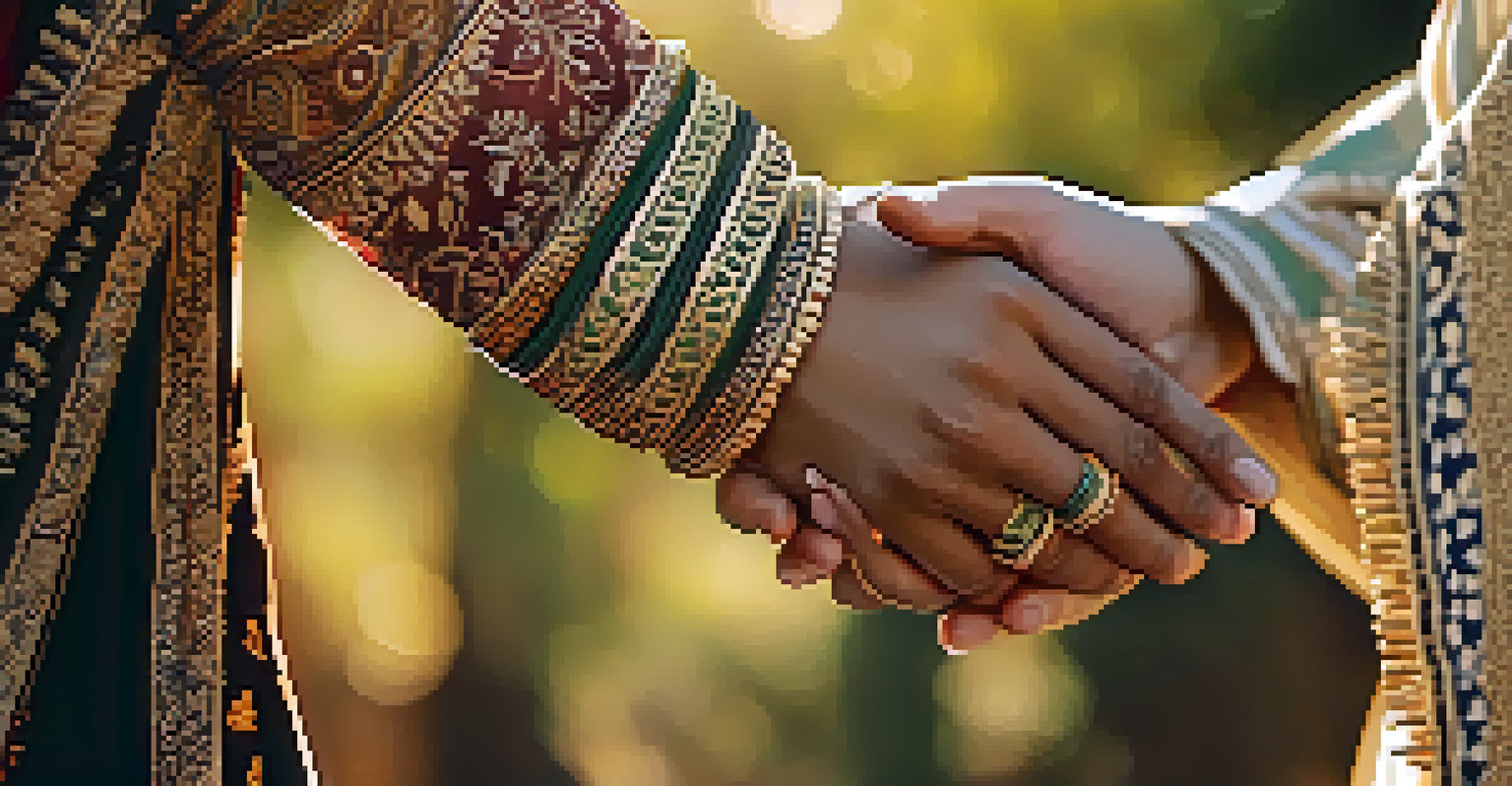Sardana: The Dance of Unity in Catalan Culture

What is Sardana: A Dance of Unity and Tradition
Sardana is much more than a dance; it is a cherished symbol of Catalan identity. Originating from the Catalan region of Spain, this dance brings people together in a circle, fostering a sense of community and belonging. The lively music and intricate movements reflect the spirit of unity among participants, making it an integral part of local festivals and celebrations.
Dance is the hidden language of the soul.
The dance is typically performed in a circle, with dancers holding hands, symbolizing connection and solidarity. Each step and movement in the Sardana tells a story, showcasing the rich cultural heritage of Catalonia. As people join hands and dance, they not only express joy but also celebrate their shared history and values.
Participants often wear traditional attire, which adds to the vibrant atmosphere of the dance. Engaging in Sardana allows individuals to immerse themselves in Catalan culture while promoting a sense of togetherness. It's a beautiful representation of how dance transcends language and differences, uniting people from all walks of life.
The Historical Roots of Sardana in Catalonia
The origins of Sardana trace back to the 19th century, during a time of cultural revival in Catalonia. As Catalans sought to reclaim their identity and traditions, Sardana emerged as a powerful symbol of regional pride. The dance was initially seen in rural communities, where it flourished as a means of social gathering and celebration.

Over the decades, Sardana evolved into a more structured form, gaining popularity in urban areas as well. Festivals, known as 'sardanistes,' were organized to promote and preserve this cherished dance. These events not only showcased the dance itself but also encouraged community participation, reinforcing the cultural significance of Sardana.
Sardana: A Symbol of Unity
Sardana is a traditional Catalan dance that fosters community and belonging through its inclusive circular movements.
Today, Sardana is recognized as a national cultural treasure, celebrated in various festivals throughout Catalonia. Its historical journey reflects the resilience of Catalan culture and the community's dedication to preserving their unique heritage. This dance serves as a reminder of the importance of cultural continuity in a rapidly changing world.
The Role of Music in Sardana: A Heartbeat of Tradition
Music is the lifeblood of Sardana, providing the rhythm and energy that fuels the dance. Typically accompanied by a cobla, a traditional Catalan wind band, the music combines brass instruments and percussion to create a lively atmosphere. The melodies are often uplifting, inviting everyone to join in and celebrate together.
Tradition is not the worship of ashes, but the preservation of fire.
Each Sardana has a specific tempo and structure that guides the dancers' movements. The music not only dictates the pace but also enhances the emotional experience of the dance. As the notes fill the air, they evoke feelings of joy and nostalgia, connecting participants to their cultural roots.
Furthermore, the relationship between the dancers and the musicians is essential to the Sardana experience. Musicians play a crucial role in setting the mood, while dancers respond with their movements, creating a beautiful synergy. This interplay emphasizes how music and dance work hand in hand, reinforcing the communal aspect of Sardana.
Sardana Today: A Living Tradition in Modern Catalonia
In contemporary Catalonia, Sardana continues to thrive as a vibrant part of cultural life. It is practiced in schools, community centers, and during local festivals, ensuring that younger generations are introduced to this cherished dance. The commitment to preserving Sardana is evident, as many communities actively participate in workshops and classes.
Moreover, Sardana has adapted to modern influences, integrating contemporary elements while maintaining its traditional essence. This evolution allows the dance to remain relevant and appealing to diverse audiences. As a result, it attracts not only locals but also tourists seeking a glimpse into Catalan culture.
Cultural Heritage and Resistance
The dance serves as a powerful expression of Catalan identity and cultural resilience, particularly during times of suppression.
Events like the 'Sardana Festival' bring together dancers from various backgrounds, reinforcing the idea of unity through dance. These gatherings celebrate not just the dance itself but also the shared values of community, respect, and cultural pride. Sardana's ability to evolve while staying true to its roots is a testament to its enduring significance.
How to Participate in Sardana: Join the Circle
Joining a Sardana is an inclusive experience, welcoming anyone interested in participating. You don’t need prior dance experience; the joy of Sardana lies in its simplicity and communal nature. Many local festivals offer opportunities to learn the basics, making it accessible for all ages and backgrounds.
To get started, look for local Sardana events or classes where experienced dancers guide newcomers through the steps. The atmosphere is warm and inviting, with seasoned participants eager to share their love for the dance. As you join the circle, you’ll quickly feel the camaraderie and connection that Sardana fosters.
Remember, the essence of Sardana is not about perfecting every move but embracing the joy of dancing together. As you hold hands with fellow dancers, you become part of a larger story that celebrates unity and tradition in Catalan culture. So, lace up your dancing shoes and get ready to join in the fun!
Sardana and Its Cultural Significance in Catalonia
Sardana holds a profound cultural significance in Catalonia, acting as a symbol of regional identity and pride. The dance transcends mere entertainment; it embodies the values of solidarity and community. Participating in Sardana allows individuals to connect with their heritage and express their love for Catalonia.
The dance has also become a form of cultural resistance, particularly during periods when Catalan identity faced suppression. By continuing to celebrate Sardana, Catalans assert their cultural autonomy and resilience. This dance serves as a reminder of the power of tradition in shaping collective identity.
Future of Sardana: Adaptation
Sardana is evolving to engage younger generations through modern influences and technology while preserving its traditional essence.
Moreover, Sardana has gained recognition beyond Catalonia, attracting interest from people around the world. Its unique blend of music, movement, and community spirit has inspired various cultural exchanges. As more people engage with Sardana, its legacy continues to grow, bridging gaps and fostering understanding across cultures.
The Future of Sardana: Preserving a Cultural Heritage
Looking ahead, the future of Sardana hinges on the commitment of communities to preserve and promote this dance. Efforts are underway to ensure that younger generations are not only aware of Sardana but also actively involved in its practice. Schools and cultural organizations are key players in this mission, providing educational resources and opportunities for participation.
Additionally, the integration of technology and social media has opened new avenues for sharing Sardana with a broader audience. Online tutorials, virtual events, and social media campaigns help spread awareness and attract interest from outside Catalonia. This modern approach allows the dance to reach diverse audiences while staying true to its roots.

Ultimately, the continued vitality of Sardana relies on the passion of its practitioners and supporters. By fostering a sense of community and belonging, Sardana will endure as a vibrant expression of Catalan culture, uniting people for generations to come. The dance not only celebrates the past but also paves the way for a dynamic future.